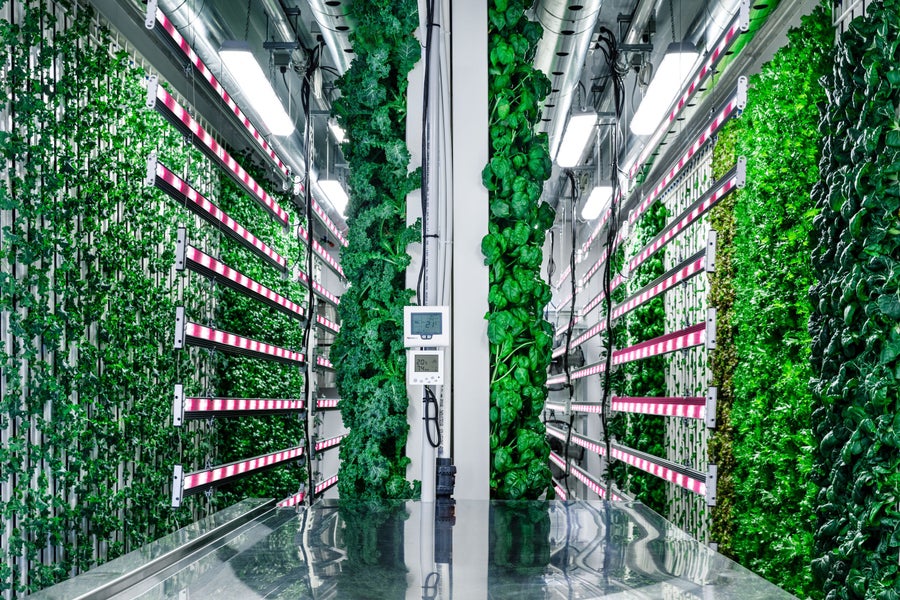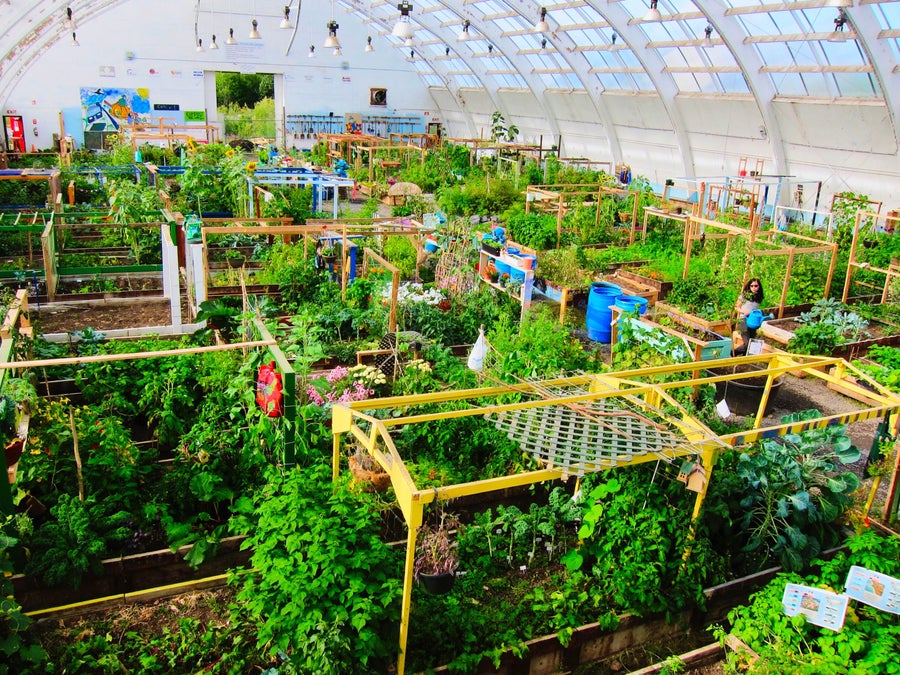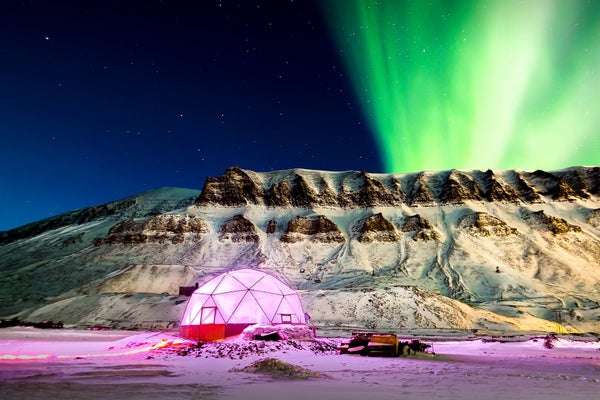Enter the Inuvik Community Greenhouse in late July and you’re met with the smell of moist earth, lush kale beds, perky sunflowers and strawberries dangling like gems from vertical hydroponic grow stations. In this indoor Eden it’s easy to forget you’re just 60 miles south of the ice-capped Arctic Ocean in Canada’s Northwest Territories.
Built 20 years ago within a converted hockey arena, this 16,000 square-foot greenhouse offers a welcome source of fresh produce in a region where food security suffers in part due to climate change and also sheer remoteness. For example, five pounds of potatoes can cost $25 due to high shipping costs. “If you can grow 100 pounds of potatoes in your greenhouse, you are alleviating some of that financial stress,” says its director, Ray Solotki. The greenhouse, however, only operates in the summer and produces just a fraction of the food this town of about 3,300 people consumes each year. Solotki is working to change that.
She’s raising funds to develop a year-round growing operation that would take advantage of new technological developments to provide more fresh food for Inuvik and surrounding towns. Customizable LED lighting, remotely operated nutrient-monitoring systems as well as more efficient and insulated building designs have all made indoor growing more productive, efficient and less costly to operate. Greenhouses that could benefit from this technology are springing up throughout the Arctic: The Japanese company JGC Evergreen produces 1,000 tons of cucumbers and tomatoes in Siberia, a group called Growing North provides geodesic dome greenhouses to communities in Nunavut, Canada, and an operation called Polar Permaculture Solutions supplies the only locally grown produce in the world’s northernmost city of Longyearbyen in Svalbard, Norway. Such efforts “are providing food and jobs and all of these things that we desperately need in our communities,” Solotki says.
On supporting science journalism
If you're enjoying this article, consider supporting our award-winning journalism by subscribing. By purchasing a subscription you are helping to ensure the future of impactful stories about the discoveries and ideas shaping our world today.

Modular Farms, an Ontario-based greenhouse company, has developed 400-square-foot containers that can produce thousands of hydroponically grown leafy greens. Credit: Modular Farms
To grow food year-round, Solotki hopes to expand her operation with Modular Farms, an Ontario-based company that builds customized container farms that can withstand harsh winter weather extremes. Plants grow hydroponically in the modules, with roots suspended in water rather than soil—although Solotki is working with the company to develop a soil-based option to more easily grow calorie-rich root vegetables like potatoes and carrots. A so-called primary module measures 44 feet long, 10.5 feet wide and contains 240 vertical hydroponic towers that can grow more than 3,800 plants under LED lights. An HVAC system maintains climate control and the custom-made steel walls are so well insulated that a module in Toronto did not need heat turned on at all last winter—the excess heat produced by the LED lights and dehumidifier was sufficient, says company president, Aaron Spiro. Frigid Arctic winters will call for some added heat, he adds, but far less than a standard shipping container or passive solar greenhouse would require.
The modules include a wireless monitoring system that tracks conditions like heat and humidity in the air and the chemistry and nutrient levels of the growing solutions the plant roots rest in. No matter the location of the modules, the company’s plant health specialist, Kevin Jakiela, keeps an eye on growing conditions from his office in Toronto, and contacts clients when he sees something amiss. “Kevin gets a notification on his phone that Tower 10 in Inuvik is low on nutrients, and he picks up the phone and says, ‘Put some of this bottle into this drip tray,’” Solotki says. “It’s really simple.” This remote assistance turns out to be invaluable in Arctic towns that may not have a local farming network to help troubleshoot problems. “We need to be able to monitor and communicate in fairly real time,” says Mark Lefsrud, a bioresource engineer at McGill University in Montreal who is working on a similar system. “Waiting weeks will result in the loss of the whole crop.”
New research looking into how different crops use different wavelengths of light will also help make indoor growing more productive in the Arctic, Lefsrud says. Scientists have traditionally touted red and blue light as optimal for plant growth because among wavelengths chlorophyll absorbs red light for photosynthesis more efficiently whereas blue light supports plant functions like the opening and closing of stomata, the small holes in leaves that release oxygen and suck up carbon dioxide. “But we have been working on other wavelengths that we see as more beneficial,” Lefsrud says, noting he has been able to improve growth by 40 percent in some plants by pinpointing wavelengths that maximize their growth. For the same amount of energy expended to generate light, growers could produce more food.
Meriam Karlsson, a horticulturalist at the University of Alaska Fairbanks, says customizing wavelengths can also increase nutritional value. One study published by Chinese researchers earlier this year showed lettuce grown under blue light contained higher levels of nutrients like flavonoids, anti-inflammatory antioxidants that offer wide-ranging health benefits, compared with lettuce grown under other wavelengths.

The Inuvik Community Greenhouse in Inuvik, Canada, has been running since 1998 and grows a variety of crops including strawberries, tomatoes, peas, lettuce and even an apple tree. Credit: Laura Poppick
Food security has also been a mounting issue in some regions of the Arctic, where diets have transitioned from subsistence hunting and gathering to store-bought processed food with high costs but low nutritional value. One study found Canadian Inuit adults who had consumed traditional meats and plants in a given day had higher levels of a variety of nutrients in their blood, including vitamins A and C, than those who consumed only store-bought food. And food access has become even more tenuous in recent years due to climate change: Traditional hunting grounds have become less reliable and harder to reach, and roads, tarmacs and riverbanks used to import food are beginning to erode as the permafrost beneath them thaws. Whereas some crops may benefit from rising temperatures, a warming Arctic will not necessarily make for easier outdoor farming in the immediate future because snow still remains piled up outside into the early summer in some locations. Parts of Alaska and elsewhere are also expected to see increased rates of climate change–driven late spring snow, which would thwart outdoor growing efforts.
Still, the cost of running lights and heating remains a steep hurdle for year-round greenhouse growing. Polar Permaculture in Longyearbyen spends about 20 cents per kilowatt-hour (kWh) on electricity and the Inuvik greenhouse spends roughly 60 cents per kWh compared with the average of about 10 cents per kWh in the U.S., in part because transporting fuel to remote communities is expensive. But with groups like Modular Farms designing well-insulated buildings that recycle incidental heat from electronics and optimize energy consumption, greenhouses could make up for those overhead costs by growing and selling more food. And as Solotki points out, “the costs of energy are high, but the costs of [food] transportation are much higher.”
Costs aside, cultural attitudes toward food cultivation also vary amongst northern indigenous communities, and some are not necessarily interested to partake in greenhouse efforts spearheaded by newcomers to the Arctic. “There is a sense that it’s not for them, it’s for the people who have come from elsewhere who are living there now,” says Sonia Wesche, a researcher at the University of Ottawa who studies indigenous health and well-being. But Solotki is working closely with Inuvialuit and Gwich’in communities—the two major indigenous groups in and around Inuvik—to help change that perception. By the end of the summer, she will have trained 11 individuals who have volunteered from surrounding communities to run smaller-scale passive solar greenhouses—ones that rely on sunlight rather than LEDs—in their own towns. Robert Charlie, director of beneficiary services with the Gwich’in Tribal Council in Inuvik says he thinks it is a good initiative. “If you can grow your own food, then why not?” he says. “It will reduce the cost of living.”
Once Solotki can raise the $350,000 needed to purchase a Modular Farm for Inuvik, she plans to continue to fund-raise to bring modules to surrounding smaller communities. Karlsson in Fairbanks says Alaskan growers are increasingly interested in these solutions as well. Even with the hurdles, she says, the new innovations in indoor growing will only strengthen northern food security. “It’s not going to solve the problem, but it is going to help.”
